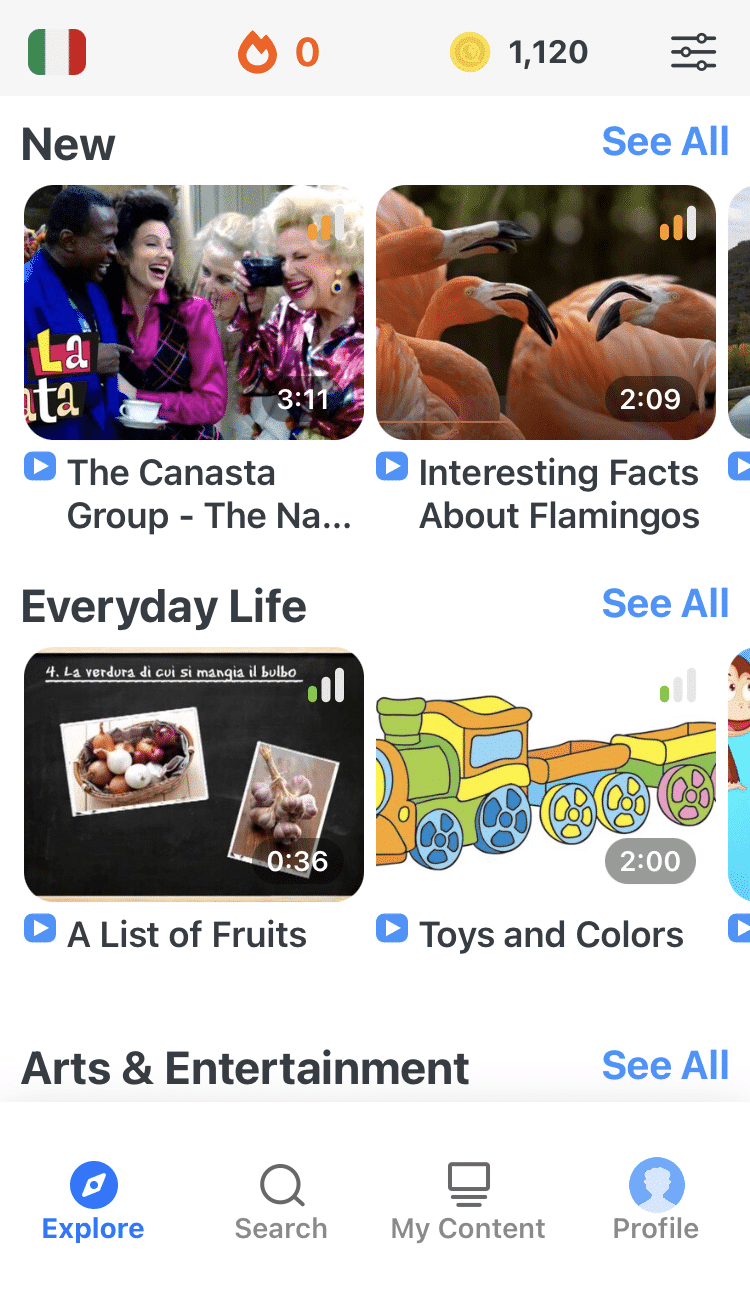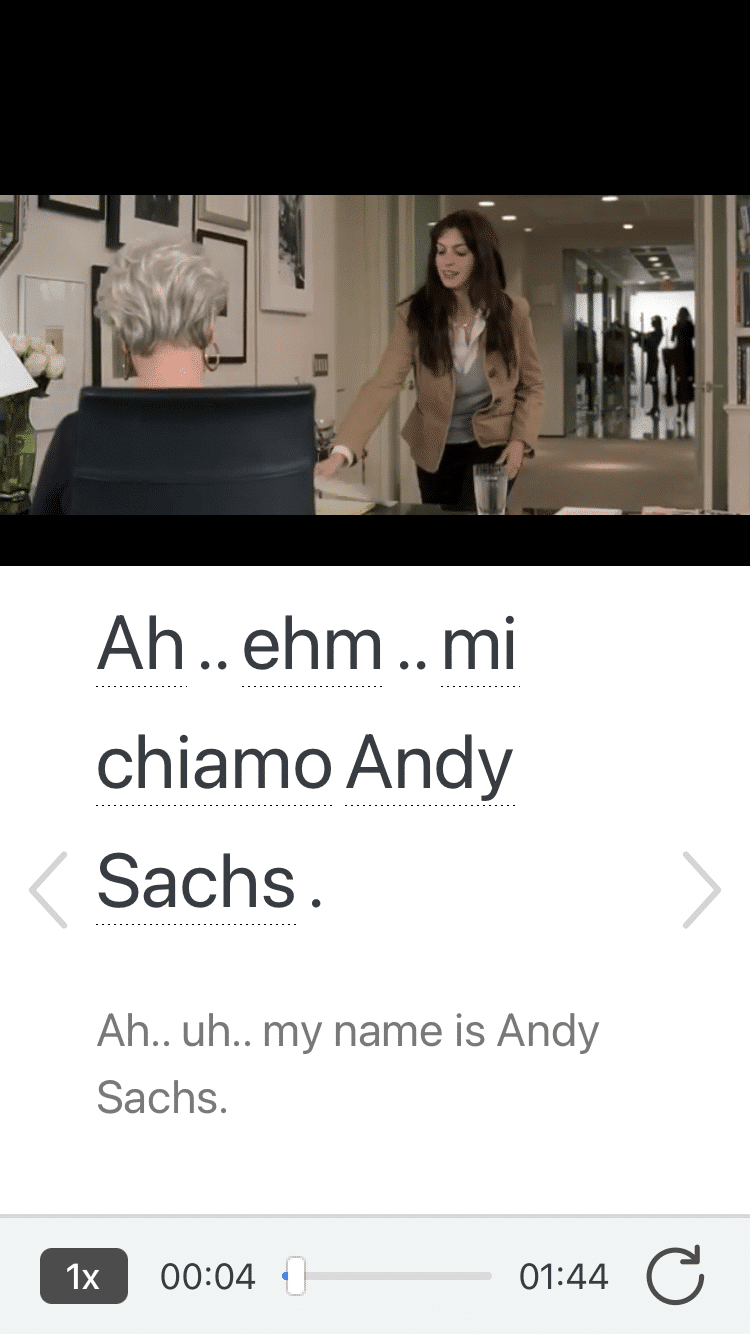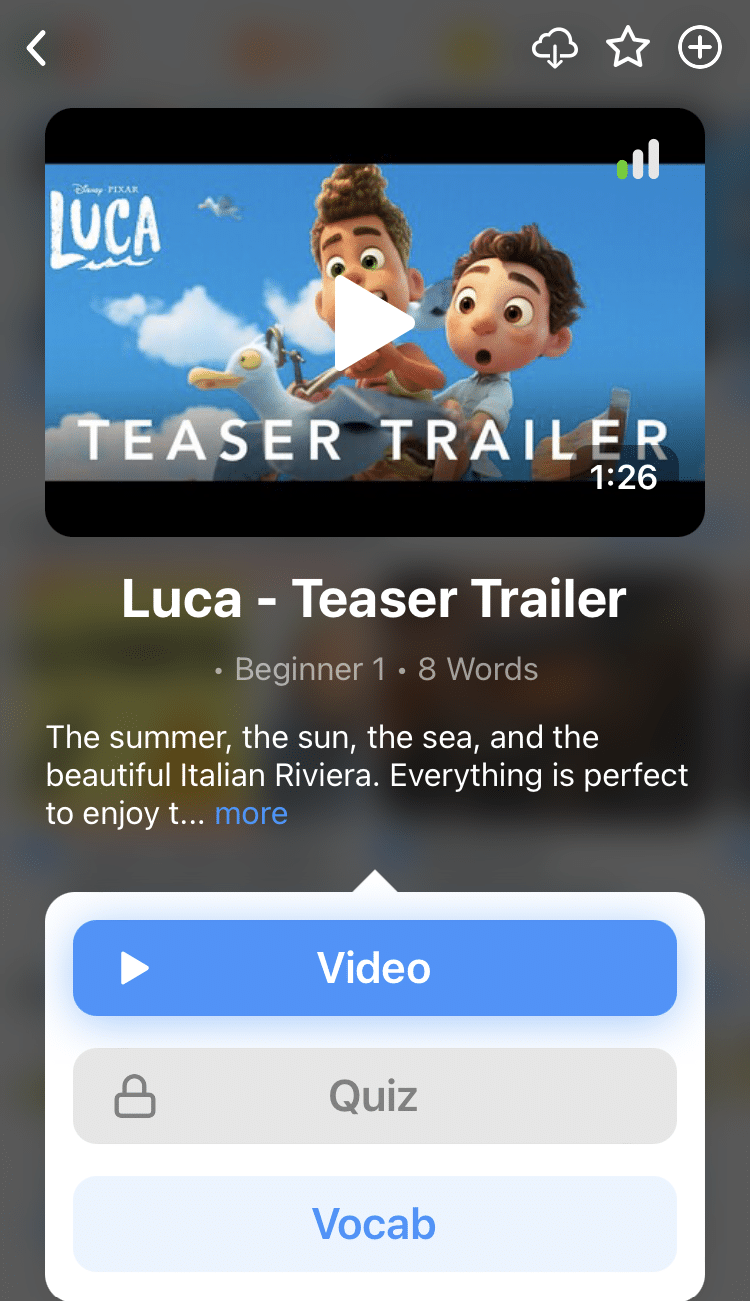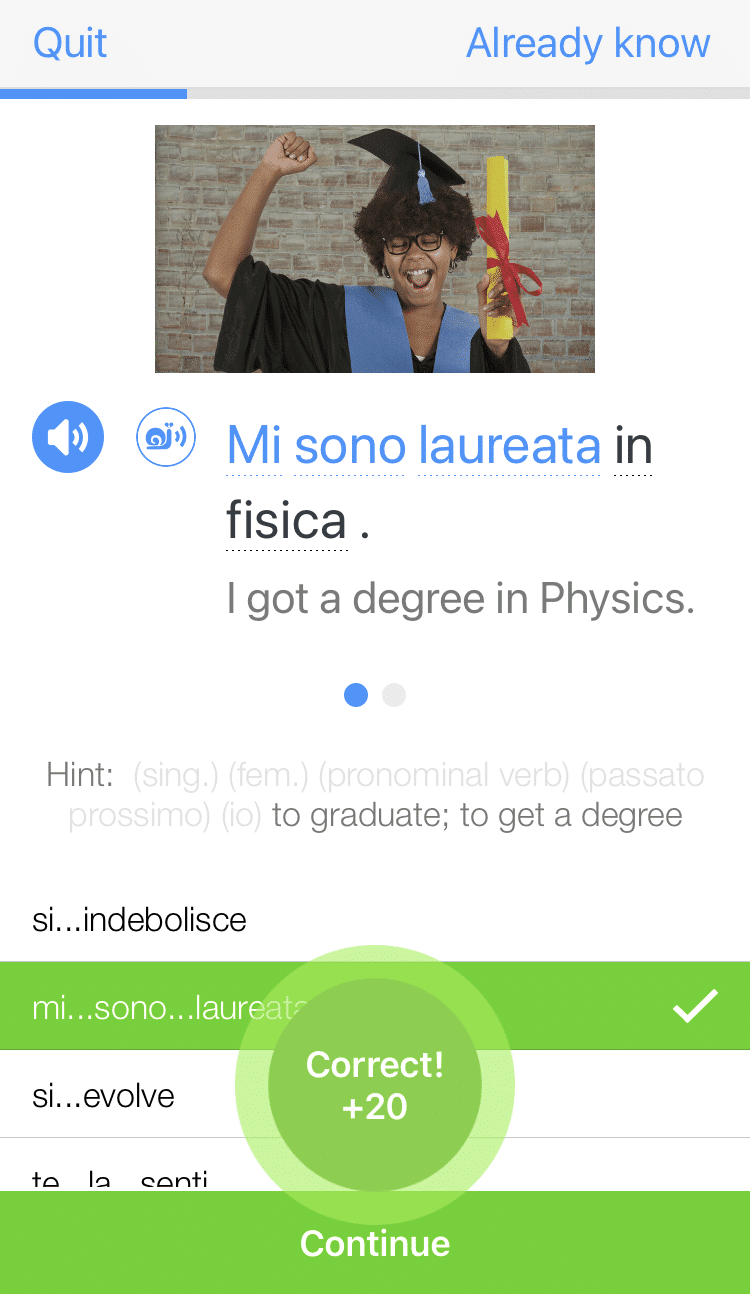
Italian Present Tense
The Italian present tense is crucial for having everyday discussions.
Since this tense is so fundamental, it’s useful to start with the four types of regular present tense verb conjugations.
In this post, I’ll go over each of these and discuss the different ways you can use the present tense in Italian (it’s a little different from other languages!).
Contents
- How to Conjugate Regular Italian Present Tense Verbs
- How to Use the Italian Present Tense in Context
- And One More Thing...
Download: This blog post is available as a convenient and portable PDF that you can take anywhere. Click here to get a copy. (Download)
How to Conjugate Regular Italian Present Tense Verbs
The infinitive (dictionary form) of Italian verbs generally ends in –are, –ere or –ire. Each of these is conjugated according to different rules.
Conjugating –are Verbs
To see what happens with the present tense of –are verbs, we’ll look at the example of cantare (to sing).
First, we take that infinitive and remove the –are ending so that we’re left with the stem cant-. Then we add the following endings, depending on the subject (who’s doing the singing):
| Pronoun | Present Tense | Conjugation Ending |
|---|---|---|
| io (I) | canto | -o |
| tu (you, informal) | canti | -i |
| Lei (you, formal) | canta | -a |
| lui / lei (he / she) | ||
| noi (we) | cantiamo | -iamo |
| voi (you all) | cantate | -ate |
| loro (they) | cantano | -ano |
Here are a couple of example sentences:
Cantano canzioni tipiche del sud d’Italia. — They sing typical songs from the south of Italy.
Canto samba rock. — I sing samba rock.
Similar –are verbs include: volare (to fly), portare (to wear, to bring) and abitare (to live [somewhere]).
There’s one irregularity you do need to be aware of: sometimes the spelling of -are verbs changes to maintain the expected pronunciation. This usually happens only with the tu and noi conjugations:
| Verb Ending | Spelling Change | Reason | Example Verb | How to Apply |
|---|---|---|---|---|
| -ciare | Drop the i from the end of the stem. | To avoid geting a strange double ii. | mangiare (to eat) | tu mangi (you eat) noi mangiamo (we eat) |
| -giare | ||||
| -care | Add an extra h to the end of the stem. | Indicates that the c or g sounds stay hard. | pagare (to pay) | tu paghi (you pay) noi paghiamo (we pay) |
| -gare |
Conjugating –ere Verbs
For present tense verbs with an infinitive ending in –ere, you’ll remove the ending and replace it with one of the following endings. We’ll take the example of credere (to believe), so the stem is cred– and the endings are:
| Pronoun | Present Tense | Conjugation Ending |
|---|---|---|
| io (I) | credo | -o |
| tu (you, informal) | credi | -i |
| Lei (you, formal) | crede | -e |
| lui / lei (he / she) | ||
| noi (we) | crediamo | -iamo |
| voi (you all) | credete | -ete |
| loro (they) | credono | -ono |
You can then make sentences like these:
Non credo in quel dio. — I don’t believe in that god.
Credi a qualsiasi cosa! — You believe anything!
Other regular –ere verbs include: scrivere (to write), conoscere (to know [someone]), leggere (to read), vincere (to win), perdere (to lose), prendere (to take), mettere (to put) and chiedere (to ask).
Conjugating –ire Verbs (Group One)
There are, unfortunately, two ways to conjugate –ire verbs in the present tense. Each time you learn a new –ire verb, you need to learn which set of conjugations is appropriate.
Here’s the first conjugation of –ire verbs. We’ll take the example of the wonderfully dramatic fuggire (to escape, run away). Removing the ending, we get fugg-, and then we add endings as follows:
| Pronoun | Present Tense | Conjugation Ending |
|---|---|---|
| io (I) | fuggo | -o |
| tu (you, informal) | fuggi | -i |
| Lei (you, formal) | fugge | -e |
| lui / lei (he / she) | ||
| noi (we) | fuggiamo | -iamo |
| voi (you all) | fuggite | -ite |
| loro (they) | fuggono | -ono |
Here they are in action:
Fuggiamo da una situazione straziante. — We’re escaping from an excruciating situation.
Fuggo dalla guerra. — I’m escaping from war.
Some of the most common verbs under this group are: aprire (to open), coprire (to cover), divertirsi (to have fun), offrire (to offer), partire (to leave), pentirsi (to regret), scoprire (to discover), seguire (to follow), sentire (to feel or to hear), servire (to serve), soffrire (to suffer), vestirsi (to dress).
(The infinitives ending in –si are reflexive verbs, which is a topic for another day. For now, it’s worth being able to recognize them as part of this group.)
This first group of -ire verbs is actually a lot smaller than the second group (below). You can simply memorize the list of common verbs here in the first group, then know that most others will fall into the second group.
Conjugating –ire Verbs (Group Two, “-isc-”)
This “second” or “isc” type of conjugation in the present tense is more common.
These verbs also remove their –ire endings and then have isc in some of their conjugations.
They’re conjugated as follows with the example verb capire (to understand):
| Pronoun | Present Tense | Conjugation Ending |
|---|---|---|
| io (I) | capisco | -isco |
| tu (you, informal) | capisci | -isci |
| Lei (you, formal) | capisce | -isce |
| lui / lei (he / she) | ||
| noi (we) | capiamo | -iamo |
| voi (you all) | capite | -ite |
| loro (they) | capiscono | -iscono |
Recall that the Italian letters sc, when followed by an e or an i, have a “sh” sound; when followed by an o, they have a “sk” sound.
Here are some example sentences:
Capisco tutto. — I understand everything.
Lei capisce la spiegazione. — She understands the explanation.
Just don’t forget that noi and voi conjugations don’t have an isc inserted in their endings! It’s common for beginning speakers to mistakenly form conjugations like noi capisciamo.
Common Patterns
Even though we have all these different Italian verb groups, there are some patterns that you’ll notice:
- lui/lei/Lei conjugation ends in -a for -are verbs but ends in -e for -ere and -ire verbs.
- loro conjugation ends in -ano for -are verbs but ends in -ono for -ere and -ire verbs.
- Noi conjugation always ends in -iamo, whether for -are, -ere or -ire verbs.
To wrap up the Italian present tense conjugation rules, check out this video summarizing them:
How to Use the Italian Present Tense in Context
Now that you know how to conjugate Italian present tense verbs, you also have to know when to use them. It’s not always the same as in English!
This is where learning in context comes in. As you get exposed to more examples of the Italian present tense, whether through talking to native speakers or consuming Italian media like books and movies, you’ll pick up how to use it in different situations.
You can use a program like FluentU, for example, to both listen to and read Italian present tense verbs in action.
FluentU takes authentic videos—like music videos, movie trailers, news and inspiring talks—and turns them into personalized language learning lessons.
You can try FluentU for free for 2 weeks. Check out the website or download the iOS app or Android app.
P.S. Click here to take advantage of our current sale! (Expires at the end of this month.)
To get you started, here are seven ways to use the Italian present tense:
To Discuss Events Happening Now
The main use of the Italian present tense is talking about things that are happening in the moment.
Loro piangono. — They’re crying. (I.e. I’m standing right in front of them and I can see them crying.)
Mandiamo un regalo a nostro nipote. — We’re sending a present to our grandson. (We’re in the post office right now.)
Il professor Rossi allena la squadra di calcio della scuola. — Mr. Rossi is drilling the school’s soccer team.
Ti spiego il mio piano. — I’m clarifying my plan for you.
Notice that in English, this here-and-now idea is often translated with gerund endings (-ing), as in, “they are crying.” While such a construction, the present continuous, also exists in Italian ( loro stanno piangendo ), it’s less common than in English and reserved for emphasizing that things are currently taking place.
Some Italians prefer to generally use the present continuous in most here-and-now situations, but it’s still perfectly correct to use the standard present tense.
To Discuss Regular Events
You can also use the present tense to discuss how things generally, habitually are (e.g., all the time, sometimes, rarely, etc.).
Mandiamo i soldi a nostro nipote tutti i mesi. — We send money to our grandson every month.
Finisco di lavorare alle 18:00. — I get off work at 6 p.m. (generally, daily).
Lavorano a casa. — They work at home.
Lasciate sempre la cucina sporca! — You (plural) are always leaving the kitchen dirty!
To Ask Questions
The same tense can be used to ask questions. Rising intonation in Italian is enough to indicate that the statement is now a question.
Take the previous two example statements— They can also be questions:
Lavorano a casa? — Do they work at home?
Lasciate sempre la cucina sporca? — Do you always leave the kitchen dirty?
Since Italian questions can look exactly the same as statements in the present tense, it’s important to raise the intonation for these sentences much more than you would in English.
Listen to some Italians asking questions and then try to mimic that level of pitch variation. You must get this right!
Otherwise, certain Italian girlfriends might fly off the handle over totally innocent questions asked by their poor American boyfriend who I swear was just seeking information and not making a statement but lacked that emphasized Italian upper inflection, and really wished they’d practiced it more…
If you don’t want to completely forswear Italian romance, a safer way to turn a present tense phrase into a question is to add a question tag at the end.
Lavorano a casa, non è vero? — They work at home, don’t they?
Lasciate sempre la cucina sporca, vero? — You always leave the kitchen dirty, huh?
Traslocano in Nord Italia, no? — They’re moving to the north of Italy, aren’t they?
Lui ci cambia sempre le carte in tavola, giusto? — He’s always changing the rules on us (literally, “changing the cards on the table”), isn’t he?
Finally, Italian’s range of interrogative adverbs, adjectives and pronouns (present continuous) can also be used with the present tense to make questions.
Perché rimandiamo sempre? — Why are we always delaying?
Con chi passi la maggior parte del tuo tempo? — With whom do you pass most of your time?
Quale restaurante chiude più tardi? — Which restaurant closes later?
With Vedere and Sentire
With the verbs vedere (to see) and sentire (to hear), the present tense on its own is enough to give the idea of being able to do these things.
Mi senti? — Can you hear me?
Vediamo il palco perfettamente. — We can see the stage perfectly.
To Discuss Upcoming Plans
The present tense can also give off a whiff of future meaning, especially when you’re talking about plans.
Domani balliamo con i brasiliani. — Tomorrow we’re dancing with the Brazilians.
Stasera proviamo la coreografia. — Tonight we rehearse the choreography.
To Discuss Ongoing Situations
The present tense can also be used in certain past situations. It, along with the preposition da and expressions of time, can be used to indicate how long something has been going on (that is, it started in the past and is still going on at present).
(In English, this is often accomplished not with the present tense but with “have/has” plus “been,” followed by the gerund.)
Da molti anni lavoro con Raffaella. — I have been working with Raffaella for years.
Mangiamo dalle 17:00. — We have been eating since 5 p.m.
Studio l’italiano da un mese. — I have been studying Italian for one month.
Abito a New York da 1997. — I have lived in New York since 1997.
To Add Some Drama
And finally, while the present tense isn’t generally used to talk about past events in conversation, you may find it being used in speeches or literature to heighten the drama of historical events. (This is sometimes but more rarely done in English as well.)
L’esercito catalano avanza per difendere la frontiera. Le forze armate del Re scappano dalla paura e il popolo dichiara la vittoria. — The Catalan army moves forward to defend the border. The king’s armed forces run off in fear and the people declare victory.
You should now be quite ready to start practicing with your own Italian sentences. As you experiment, it’s best at first to stick to lists of regular verbs; there are lots of unfortunately very common irregular verbs with different patterns.
The good news is that using the Italian present tense becomes easier to learn once you’ve really mastered the regular verbs, so take your time with these. Have fun describing how things are now, how they generally are and what’s happening around you!
Download: This blog post is available as a convenient and portable PDF that you can take anywhere. Click here to get a copy. (Download)
And One More Thing...
If you're as busy as most of us, you don't always have time for lengthy language lessons. The solution? FluentU!
Learn Italian with funny commericals, documentary excerpts and web series, as you can see here:

FluentU helps you get comfortable with everyday Italian by combining all the benefits of complete immersion and native-level conversations with interactive subtitles. Tap on any word to instantly see an image, in-context definition, example sentences and other videos in which the word is used.

Access a complete interactive transcript of every video under the Dialogue tab, and review words and phrases with convenient audio clips under Vocab.

Once you've watched a video, you can use FluentU's quizzes to actively practice all the vocabulary in that video. Swipe left or right to see more examples of the word you’re on.

FluentU will even keep track of all the Italian words you’re learning, and give you extra practice with difficult words. Plus, it'll tell you exactly when it's time for review. Now that's a 100% personalized experience!
The best part? You can try FluentU for free with a trial.
Start using the FluentU website on your computer or tablet or, better yet, download the FluentU app from the iTunes or Google Play store. Click here to take advantage of our current sale! (Expires at the end of this month.)



